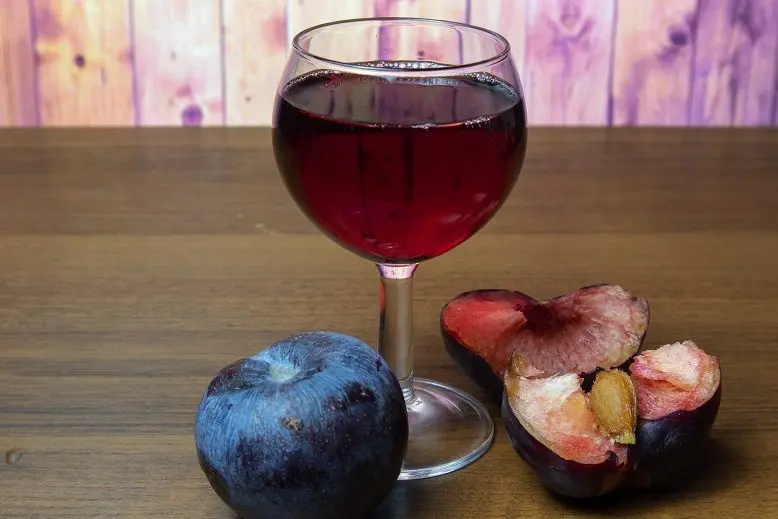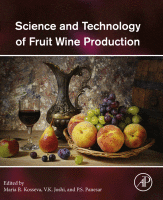Contents
Properly made wine from plums with pits is remembered for its characteristic almond flavor and slight bitterness. Although the seeds contain a small amount of cyanide and hydrocyanic acid, if the preparation technology is followed, the finished drink will turn out to be safe, since sugar neutralizes harmful substances, which are so few in the wort.
Theory
Any ripe plums are suitable, dark varieties are often used: renklod, hungarian, mirabelle, canadian, because they are more aromatic and give the drink a beautiful color, but yellow plums: egg, honey white, altai and others are also suitable for winemaking. Fruits must be free of rot and mold. Raw materials must be selected carefully, since even one bad plum can spoil the entire batch of wine.
Due to the high content of pectin, which makes the pulp jelly-like, it is problematic to obtain pure juice, so water must always be added to plum wine.
The amount of sugar depends on the sweetness of the fruit and the desired type of wine: dry, semi-dry, semi-sweet, sweet and fortified. On average, ripe plums contain 10-13% sugar, and after dilution with water, the sugar content of the must will drop to 5-6%.
To obtain a dry wine with a strength of 10-12% (the maximum alcohol content for wild yeast), the sugar content of the must should be 18-20%. It is impossible to exceed the specified concentration, otherwise problems with fermentation are possible. We will sweeten the wine after fermentation is over.
In terms of yeast, there are two options. The first is to use wild yeast, which is found on the skin of the fruit, but in this case, the plums must be harvested in dry weather and must not be washed. The second is to purchase special wine yeast and add according to the instructions on the label. Store-bought strains are preferable because they ferment better and raw materials can be washed. You cannot use baker’s or alcohol yeast, otherwise you will get fruit mash instead of wine.
In order not to infect the wort with bacteria and fungi, before starting cooking, all containers and tools should be sterilized with boiling water, then wiped dry with a clean cloth. Work only with well-washed hands.
Ingredients:
- plum fruits – 10 kg;
- water – 1 liter per 1 kg of pulp;
- sugar – 150-300 grams per 1 liter of wort.
Pitted Plum Wine Recipe
1. Remove the stones from the plucked or harvested plums, knead the pulp with the skin with your hands until a homogeneous consistency. Crush half of the seeds, remove the nucleoli (whole), the other half is not needed.
2. Pour the resulting plum puree into an enameled or plastic container (not aluminum) with a wide neck, dilute half with cold water. Add sugar at the rate of 50 grams per 1 liter of must, then throw in the nucleoli without crushing. Add wine yeast if desired. Mix.
Sugar will fall asleep fractionally in 3 even batches to maintain stable fermentation.
3. Cover the neck with a thick cloth or gauze to protect against insects. Move the container to a dark room with a temperature of 18-25°C. Leave for 3 days.
In order to prevent sourness and moldiness, stir the wort with a clean hand or a wooden stick every 6-8 hours, drowning in the juice a layer of pulp – particles of pulp and skin that have floated to the surface. Taste the wort each time, if there is too sharp almond flavor, remove the pits (nucleoli).
3-12 hours after laying, signs of fermentation should be observed – foam, hiss and a slight smell of sour, which means that everything is going fine.
4. Filter the wort through cheesecloth, squeezing the cake dry. Pour the resulting juice into a fermentation vessel, filling the vessel to a maximum of 75% of the volume, so that there is room for sugar, foam and carbon dioxide. Add a second portion of sugar to the juice – 50 grams per liter. Mix.
If the aroma of almonds seems weak, you can put a few plum kernels in the fermenting juice, but then you should check the taste every 3-5 days and, when the desired organoleptic properties are reached, remove the remaining seeds in time.
5. Close the container with future wine with a water seal of any design, even a medical glove with a pierced hole in one of the fingers will do.

6. Transfer the must to fermentation in a dark place (can be covered with a thick cloth) with a temperature of 20-28°C. After a couple of hours, the water seal should begin to bubble or the glove should inflate.
7. After 5-6 days from the moment of installation under the water lock, add the third portion of sugar – 50 grams per 1 liter. To do this, remove the water seal, pour 0,5 liters of wort through a tube for each kilogram of sugar introduced, dissolve the sugar in the juice, then pour the resulting syrup back into the fermentation tank and close it again with a water seal.
Depending on the yeast and temperature, the fermentation of wine from pitted plums lasts 30-50 days. The end of the process is indicated by the absence of bubbles from the water seal (the glove has deflated), a layer of loose sediment at the bottom and clarification of the wort.
If fermentation has not stopped after 60 days, in order to avoid strong bitterness and a rotten smell, you need to remove the drink from the sediment, then leave it to ferment under a water seal at the same temperature.
8. Drain the young plum wine into another container through a straw, without touching the sediment at the bottom. Taste the drink. Sweeten with sugar if desired (quantity is up to you). You can also increase the strength by adding alcohol or vodka – 2-15% of the volume. Fortified wine keeps better, but is tougher.
9. Pour the drink into the aging containers, trying to fill up to the neck, minimizing contact with oxygen. Close hermetically (if sugar was added at the previous stage, keep under a water seal for the first 7-10 days), transfer to a refrigerator or cellar for maturation, the recommended temperature is 3-16°C.
The minimum exposure time is 60 days, the optimal one is 5-8 months. Aging significantly improves the taste of wine.
10. As sediment appears in a layer of 3-5 cm (at first every 5-10 days, then less often), filter the wine by pouring it through a tube into another container. The drink is considered ready when the sediment no longer appears.
11. Pitted plum wine (almond flavor) can be left in containers for maturation or bottled for long-term storage. Shelf life in refrigeration or basement with full sealing – up to 5 years. Fortress – 10-12%.











